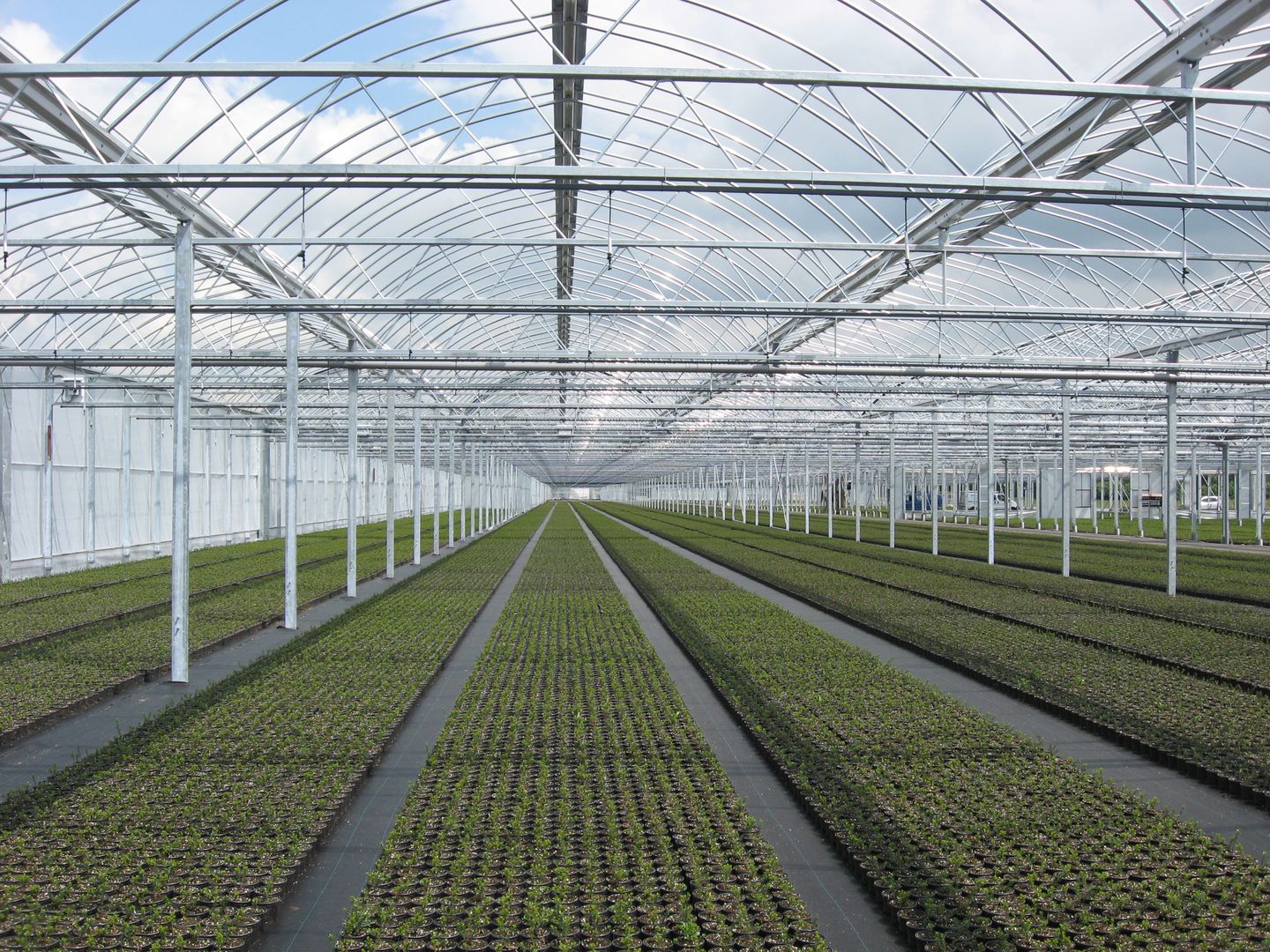

Roll-Air greenhouse creates experience at Intratuin Barneveld - Case Study
Rovero is having a lot of success with the Roll-Air greenhouse. This revolutionary greenhouse is usually used in nurseries, but the system has now also been built for the first time in a garden centre in our country. Intratuin Barneveld has the scoop. Jan van Hemert (Rovero) and Ton Uljee (Intratuin Barneveld) give us a detailed look at the new greenhouse.
Intratuin Barneveld has the scoop. Jan van Hemert (Rovero) and Ton Uljee (Intratuin Barneveld) give us a detailed look at the new greenhouse. Rovero, a specialist in plastic greenhouses and tunnels, has built a Roll-Air plastic greenhouse at Intratuin Barneveld to partially cover the outdoor area. It is the first of its kind in the Netherlands. A Roll-Air greenhouse for a garden centre is quite unique in our country. In surrounding countries, particularly England, Ireland and the Scandinavian countries, cabrio greenhouses are already widely used. Why only here now? I think that Dutch garden centres are more attached to glass greenhouses - which are often very beautiful, by the way. The Roll-Air greenhouse creates a certain atmosphere; it looks as if you are shopping outside. You close it when the weather is bad. You create a certain experience; that was also Intratuin Barneveld`s approach. We hope that this will become a trend in the Netherlands`, according to Jan van Hemert.
Ton Uljee (property owner/advisor at Intratuin Barneveld) adds: `Many garden centres opt for a fixed greenhouse with several rows of ventilation in it, or an open sky greenhouse. But in my experience, these are still buildings you stand in. With so many hard materials and technology around you, there is more of an indoor atmosphere. We think: outside is outside, and it should really feel like "outside". You have those convertible greenhouses where the lugs open up. This Roll-Air greenhouse is even more fragile, lighter and more beautiful - even more "outdoors", and that is exactly what we wanted.`
England
The idea of the cabrio greenhouse was picked up in England, where this phenomenon has been present in garden centres for some time. Van Hemert: `Intratuin Barneveld contacted us and that is how the ball got rolling. This greenhouse is different from the standard greenhouses we usually build for tree nurseries. The roof width of 9.60 metres is standard. However, the length of the compartments is different, namely 9.00 metres instead of 4.50 metres. We did this in order to have as few columns as possible in the canopy. That way you have more of an open atmosphere and fewer obstacles, also in connection with the layout of the shop and the walkways.
According to Van Hemert, the requirements for a greenhouse in a garden centre are different from those of a production greenhouse for a grower. The requirements are stricter; that has to do with the fact that there are shoppers. But we already had experience of that, especially abroad.`
Before the Roll-Air greenhouse got the go-ahead in December 2019, there was a period of consultation and adjustments to the design. Customers also have their own ideas about the design, so you are regularly sparring. It also has to be technically feasible. It has become truly customised. During this process, an architect was also engaged, Theo de Git of Breddels Architects. He supervised the project and discussed the technical side with us, as did Ton Uljee. For example, we had to add a facade of the glasshouse to the existing facade of the garden centre, which meant we had to make some adjustments. We built the entire greenhouse with our own subcontractor.`
Uljee looks back on the realisation of the project with great satisfaction. Initially, the idea was to sacrifice part of the cold greenhouse for the entrance and an escalator for trolleys. As a result, we would have lost a lot of space in the cold store and would have had to build an additional large covered outdoor area. But in the end, that plan fell through and we chose to build a larger section outside, but with the Roll-Air system. Now we have more than half of the outdoor area covered.`
Uljee continues: `The tender was quite short, but all credit to the team who built it. I`ve never seen a team build so modestly, so disciplinedly and so quickly. That was super. It was exciting for a while, because it had to be ready at the beginning of March. A shop had to be ready for the season. And that worked. We had a few fantastic weeks in the new section, but then the corona crisis hit.
Van Hemert highlights the major advantages of the Roll-Air greenhouse: `It is an open-ended system. You can roll open the greenhouse completely, so that you get the outside climate inside. The production greenhouse is mainly used for growing plants and trees and then for hardening off, after the greenhouse has been opened; with the greenhouse in the garden centre you create atmosphere. You can open and close the roof quickly and thus respond to the weather conditions. The facades can also be closed or opened, but Intratuin has chosen to leave three open. The open character is the most important aspect for the garden centre. The glasshouse is also useful during the Christmas season, when customers can admire the Christmas trees, which are normally outside, inside if necessary.`
`I am always talking about outside; you could ask why we built the glasshouse.` Uljee wants to highlight three aspects that played a major role. The first is night frost. It`s a tragedy if you have fragile plants outside that run the risk of being damaged ten to twelve times in the spring. Hauling everything indoors is extremely labour intensive and the stuff doesn`t get any better either. Secondly, wind and rain can throw a spanner in the works during the season. Customers don`t come when it rains. Thirdly, we have the Christmas tree sale outside. If it is very cold or snowing, it is almost impossible for our staff and customers to do that. Or think of last year, when it rained almost all the time.`
Van Hemert continues: We said to each other: we have to do something about it. When the greenhouse is open, you are really walking outside, but if necessary, you can easily turn off the elements with a Roll-Air greenhouse. Along the way, we discovered something else. The greenhouse is exactly north-south and the roofs run east-west, so that half of each roof faces exactly south. If it is very sunny and warm, the greenhouse can be closed on the south side, giving you shade. In summer, for example, you can make sure that the hydrangeas are not in direct sunlight. And in winter and early spring, you can close the roof and enjoy the sunshine and a pleasant temperature.
As mentioned, the Roll-Air greenhouse also has aesthetic properties. The space is open, but it does reduce the height a little. The materials that are displayed there therefore appear somewhat larger. A sprinkler system has also been installed, which makes it possible to irrigate very accurately without wind. And of course you can let the natural rain do its work by opening the roof. That is better than cold groundwater,` says Uljee.
The new greenhouse is connected to what we call the lukewarm section of our centre, which we keep frost-free. So an area has been built against it that largely keeps out the weather. As a result, there is less heat loss during the winter months and the climate in the existing greenhouse remains more pleasant.`
Uljee has noted that customers greatly appreciate the experience in the new greenhouse. With this beautiful spring weather, you can just walk around and shop outside. He expects to enjoy the new glasshouse for a long time to come. And if the film runs out in a few years` time, we will put new film on it. Intratuin Barneveld wants to give customers the feeling that they are close to nature.
Van Hemert expects this project in Barneveld to be followed by others. There are already several garden centres that want to come and see it and we have already received a request for a similar greenhouse from another garden centre.
The plastic greenhouse at Intratuin is 57.60 metres wide (six 9.60-metre sections) and 27.00 metres long (three 9.00-metre sections). By also working with lattice trusses under the gutters, larger sections can be made, which means that fewer columns are needed. The gutter height is 4.50 metres. One facade is equipped with an air vent, one is built against the existing building and the other facades remain open.
